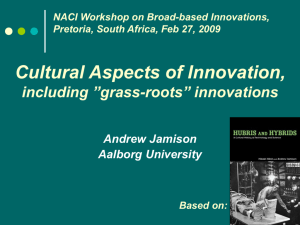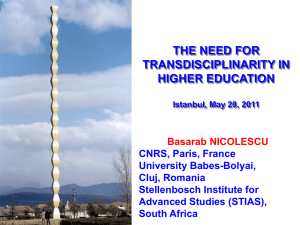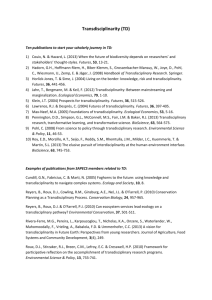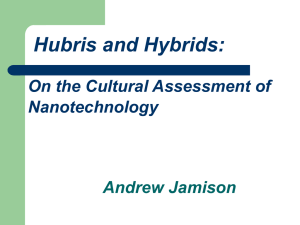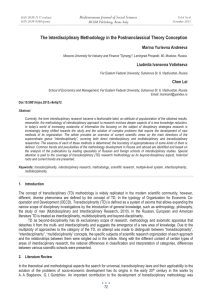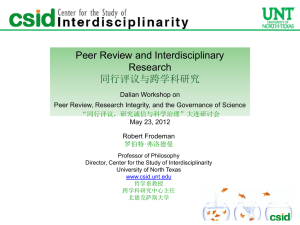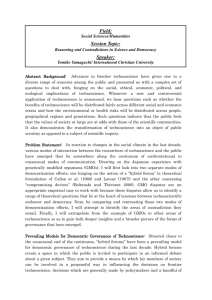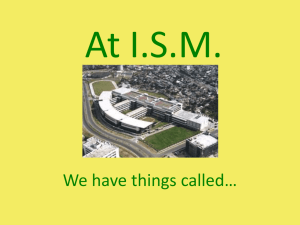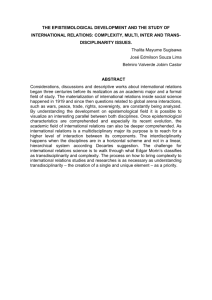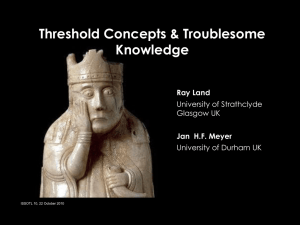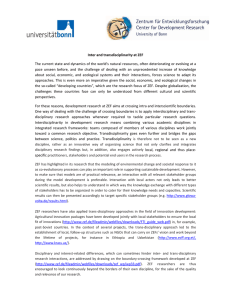Lecture 5 (Changing Contexts of Science)
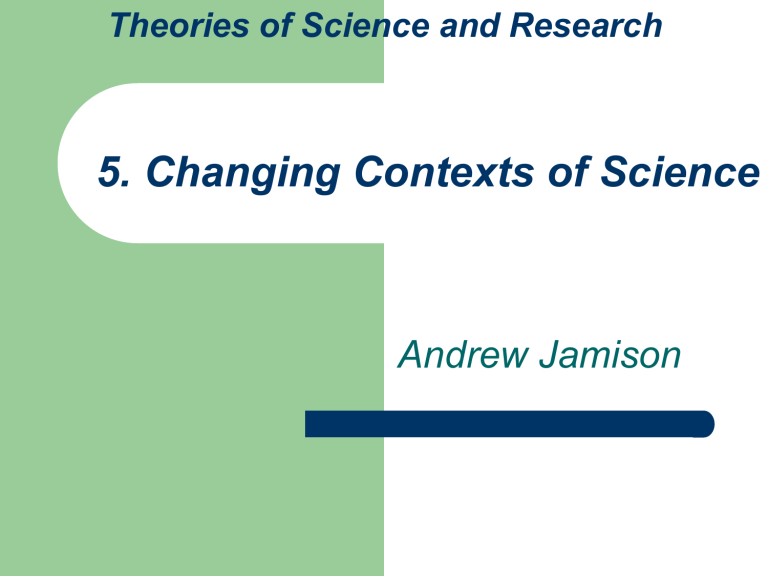
Theories of Science and Research
5. Changing Contexts of Science
Andrew Jamison
Changing Relations Between
Science and Society
risk society and uncertain knowledge (Beck)
post-normal science (Ravetz)
a new mode of knowledge production (Gibbons et al)
from science to research: constructivism (Latour)
The Risk Society Thesis (Beck)
a variant of post-industrialism
outgrowth of nuclear energy and biotech debates
from production of ”goods” to ”bads”
the ”manufacturing of uncertainties”
need for ”reflexivity” about the limits of science
Post-normal science (Ravetz)
Science and politics distinction no longer valid
Related to change from government to governance
Rise of new fields of management (e.g. EM)
An inherent complexity in understanding risks
A need for a policy-oriented risk assessment
Changing Modes of
Knowledge Production
Mode 1 Mode 1 ½ Mode 2
“Little Science” “Big Science” “Technoscience”
Before WWII 1940s-1970s 1980s-
Type of
Knowledge disciplinary multidisciplinary transdisciplinary
Organizaindividuals or R&D departments ad hoc projects and tional form research groups and institutes networks
Dominant values academic bureaucratic entrepreneurial
The Norms of Science (Merton)
a sociology of ”little science”
a defense of science from communism and nazism
”institutional imperatives” of science
related to liberal political philosophy
CUDOS: commun(al)ity, universalism, distinterestedness, organized skepticism
From Little Science to Big Science
result of use of science in WW2
change in size and scale
mission orientation, external control
university-government collaboration
bureaucratic norm, or value system
new role for the state: ”science policy”
Critiques of Big Science in the 1960s
moral, or spiritual (e.g. Martin Luther King)
– against injustice,”poverty of the spirit”
– for a new morality, or sense of justice
ecological, or internal (e.g. Rachel Carson)
– against reductionism, ”the abuse of the planet”
– for a new, environmental science
humanist, or cultural (e.g. Lewis Mumford)
– against hubris, ”the myth of the machine”
– for an appropriate technology
The Moral Critique
”When we look at modern man, we have to face the fact that modern man suffers from a kind of poverty of the spirit which stands in glaring contrast to his scientific and technological abundance. We’ve learned to fly the air like birds, we’ve learned to swim the seas like fish, but we haven’t learned to walk the earth like brothers and sisters.”
Martin Luther King, Jr
The Ecological
Critique
”The road we have long been traveling is deceptively easy, a smooth superhighway om which we progress with great speed, but at its end lies disaster.”
Rachel Carson
The Humanist
Critique
“A good technology, firmly related to human needs, cannot be one that has a maximum productivity as its supreme goal: it must rather, as in an organic system, seek to provide the right quantity of the right quality at the right time and the right place for the right purpose.”
Lewis Mumford,1961
Appropriate Technology in the 1970s
Nordic Folkcenter for Renewable Energy
Tvindm øllen
1977-1978
From Big Science to Technoscience
change in range and scope
market orientation, corporate control
university-industry collaboration
entrepreneurial norm, or value system
the state as strategist: innovation policy
from assessment to promotion: ”foresight”
The Age of Technoscience
blurring discursive boundaries
– between science (episteme) and technology (techne)
breaking down institutional borders
– between public and private, economic and academic
mixing skills and knowledge
– across faculties, disciplines, and societal domains
Contending Cognitive Strategies
The dominant , or hegemonic strategy (mode 2): commercialization, entrepreneurship, transdisciplinarity
The residual, or traditionalist strategy (mode 1): academicization, expertise, (sub)disciplinarity
An emerging, or sustainable strategy (mode 3): appropriation, empowerment, interdisciplinarity
Transdisciplinarity, or Mode 2
”Knowledge which emerges from a particular context of application with its own distinct theoretical structures, research methods and modes of practice but which may not be locatable on the prevailing disciplinary map.”
Michael Gibbons et al, The New Production of Knowledge
(Sage 1994, p168)
Contextual Differences
Mode 1 Mode 2 forms of structural specific funding (sub)national (trans)national main university work sites departments clusters of excellence project networks framing device disciplinary paradigms particular contexts of application
Cognitive Differences
Mode 1 Mode 2 cumulative unified cooperative objective universal discontinuous pluralist competitive constructive situated
The Tendency to Hubris
transgressing established forms of quality control
–
”a drift of epistemic criteria” (Elzinga)
transcending human limitations
–
”converging technologies” (bio, info, cogno, nano)
neglecting public participation and assessment
– lack of accountability and precaution
overemphasis on entrepreneurship
– propagation of competition rather than cooperation
The Forces of Habit(us)
Technoscience primarily seen as providing new opportunities for scientists and engineers
Taught by restructuring established scientific and engineering fields: multior ”subdisciplinarity”
Politics and the rest of society left largely outside of research and education: ”outsourcing” of ethics
A continuing belief in separating experts and their knowledge from contexts of use
The Discipline as Habit(us)
“A discipline is defined by possession of a collective capital of specialized methods and concepts, mastery of which is the tacit or implicit price of entry to the field. It produces a ‘historical transcendental,’ the disciplinary habitus, a system of schemes of perception and appreciation (where the incorporated discipline acts as a censorship).”
Pierre Bourdieu, Science of Science and Reflexivity (2004)
The Need for a ”Mode 3”, or a Hybrid Imagination
At the discursive level
– making connections, combining ideas
At the institutional level
– creating meeting places, building bridges
At the practical/personal level
– fostering hybrid competencies and identities
Inter- or transdisciplinarity?
Interdisciplinarity Transdisciplinarity integration of disciplines transcendence of disciplines
(internal) problem-driven (external) project-driven
”bottom-up”, self-organized ”top-down”, formalized a communicative rationality an instrumental rationality
Types of Interdisciplinarity
Collaboration
– synthetic integration
– a sharing of experience and identity
Cooperation
– project-based teamwork
– a process of collective learning
Types of Transdisciplinarity
Nondisciplinarity, or niche-seeking
– a conceptual competence
– theory, or technique-based identity
Subdisciplinarity, or specialization
– a methodological competence
– topic, or area-based identity
For example: STS
Science, Technology and Society
–
– interdisciplinary education and research bridging the ”two cultures” gap
Science and Technology Studies
– transdisciplinary and heterogeneous field
– related to growth of EU research programs
Science, Technology and Society
Collaboration
– finalization, science dynamics
– technology assessment, science shops
Cooperation
– European Association for the Study of
Science and Technology (EASST)
– educational exchanges and PhD networks
Science and Technology Studies
Nondisciplinarity, or niche-seeking
– social construction of technology (SCOT)
– actor-network theory, technology foresight
Subdisciplinarity, or sectorial specialization
– science and technology policy
– innovation studies, knowledge management
For example:
Environmental and Urban Studies
Environmental and Planning Science(s)
– interdisciplinary centers and departments
– internally-driven and often academic-oriented
Environmental and Urban Management
–
”add-on” masters and doctoral programs
– externally-driven and often market-oriented
Interdisciplinary Environmental and
Planning Sciences
Collaboration
– human ecology, social ecology
– sustainability science, ecological economics
Cooperation
– IBP, IPCC and other international programs
– environmental science departments
Transdisciplinary Environmental and
Urban Management
Nondisciplinarity
– Urban sustainable development
– Environmental impact analysis, LCA
Subdisciplinarity
– Environmental ethics, urban policy
– Energy planning, sociology of mobility
